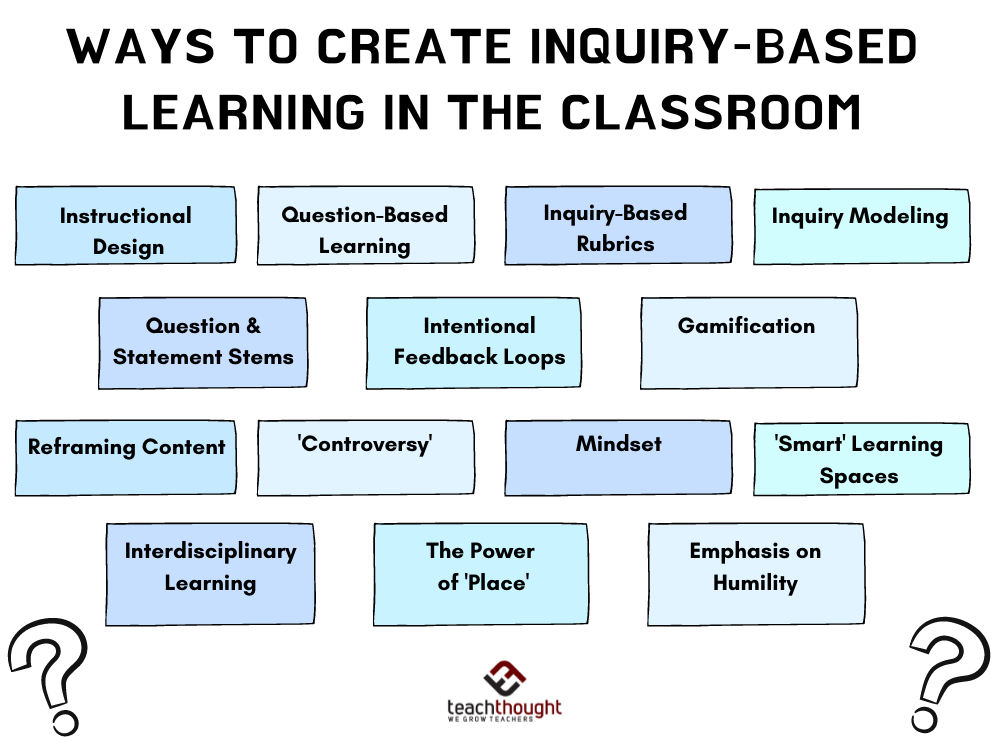


by TeachThought Staff
Inquiry-based learning is an approach to learning guided by students through questions, research, and/or curiosity.
An inquiry-based learning strategy is simply a way to facilitate inquiry during the learning process. It might be useful to think of ways to suppress inquiry to emphasize the strategies that might be used to promote it.
Years ago in the (tongue very much in cheek) 12 Ways To Kill A Learner’s Curiosity, I said that limiting choice, thinking in black and white, and focusing on answers instead of questions were just a few ways to stifle inquiry and curiosity.
In Strategies For Creating An Inquiry-Driven Classroom, professional development facilitator Irena Nayfeld offered that “children want to understand the world around them, and naturally reveal their interests by asking questions – sometimes even too many questions! As educators, we may feel pressure to keep going with our intended lesson plan or to get to our ‘point.’”
Let’s take a look at how to promote inquiry-based learning in your classroom.
14 Ways To Promote Inquiry-Based Learning In The Classroom
1. Instructional design
One of the most powerful ways to promote inquiry learning in your classroom is to design activities, lessons, and units that benefit from, promote, or require inquiry. Without ‘room’ or a ‘role’ for inquiry in your classroom, it will be difficult to ’cause’ sustainably.
Good essential questions can be useful here, too.
2. Question-Based Learning
Question-based learning is a TeachThought framework for learning through the formation and revision of questions over the course of a specific period of time. You can read more about Question-Based Learning. This also can be combined with student-led or self-directed learning where students ask their own questions, which, if done in an authentic (to the student) way, should result in more sustainable inquiry as well.
Also, see questions to guide inquiry-based learning.
3. Inquiry-based rubrics and scoring guides
By defining and itemizing individual facets of inquiry and framing what it looks like at different proficiency levels, students can be more clear about exactly what you’re hoping to see them capable of and ‘doing’ as a result of the activity or lesson.
4. Model inquiry
This can be done in many ways, including dialogic conversation, Socratic Seminars, and think-alouds, among others.
5. Use question and statement stems
Sometimes, students don’t know the mechanisms or patterns of inquiry, and question and statement stems can act as training wheels to help get students moving toward sustained, authentic inquiry. You can see some examples of sentence stems for higher-level discussion, for example.
6. Intentional Feedback Loops
Reward ‘Cognitive Stamina’ by encouraging students to ‘dwell’ on a topic or extend inquiry even when hitting dead-ends, the assignment is ‘over,’ or they’re unsure where to ‘go’ next. Consider some kind of ‘inquiry-driven grading’ where you adjust grading processes to accommodate this unique approach to learning.
The brain works through feedback loops. Roughly put, students do something, and something happens in response. The tighter and more intentional the feedback loops are for applying inquiry, the more likely it is to ‘stick.’
See also What’s a Feedback Loop In Learning?
7. Gamification
Reward points for great questions. Even consider assigning ‘points value’ to great questions–perhaps even higher ‘point values’ than the answers themselves.
You could also provide ‘levels’ for students to progress through (based on points, for example). Reward curiosity with immediate positive feedback. (See #6 above.)
8. Reframe content
Math, science, social studies, language arts, and other traditional content areas overflow with fascinating concepts, topics, histories, legacies, people, etc. ‘Position’ content in a new way that is fresh, provocative, or even controversial (see below). Inquiry is more natural when ideas are interesting.
9. Controversy sells
‘Banned books’ or other (mild to moderate) controversies can go a long way in sustaining student engagement–which sets up the stage for inquiry.
10. Clarify the role of mindset in inquiry
This can be done partly by clarifying the value of mistakes and uncertainty in the learning process.
11. Use ‘smart’ learning spaces
Design physical learning spaces to promote interaction, access to digital and physical media, and spontaneous collaboration. Artfully design spaces with color, light, and furniture, etc.
12. Leverage interdisciplinary learning
Work with teachers across content areas and grade levels to increase interdependence and ‘gravity’ of student work
13. The power of ‘place’
Connect students with experts and local organizations to embed work in places native to that student. This is obviously more complex than can be explained as a line item in a single post but just imagine the role of ‘setting’–how much more at ease and natural and connected students are in places native to them–communities or homes or neighborhoods or streets or cities they care about and have a history with that is inseparable from the student.
14. Emphasize humility
You can read more about this idea from a separate post, I wrote on learning through humility.